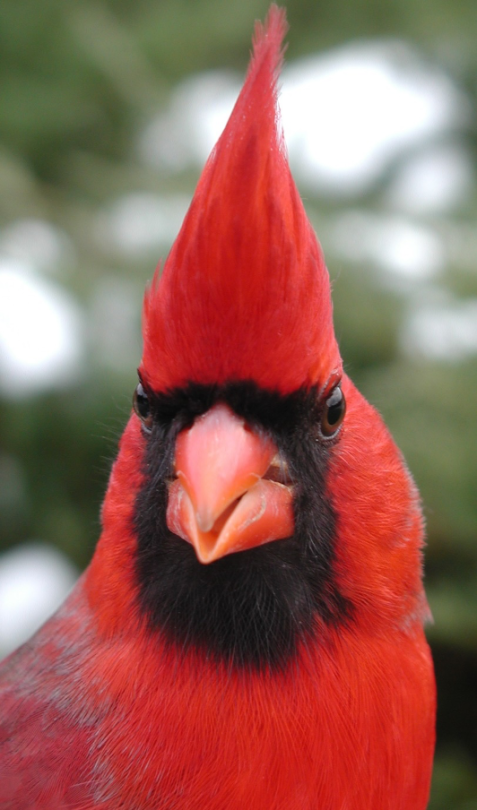How do we identify birds? Some, like this Northern Cardinal, are easy because they are very distinctive. Others, like this lineup of thrushes, are more subtle and require a bit more sleuthing.

A male Northern Cardinal’s distinctive red plumage, crest, and heavy, seed-cracking beak make him an easy bird to identify.

At first glance, these thrushes look very similar and could be confused as the same species (left to right: Hermit Thrush, Swainson’s Thrush, Gray-cheeked Thrush).
What identification steps do we take when we encounter a bird that looks similar to other birds? The first step is to try to narrow down which taxonomic group the bird belongs to. This might sound daunting, but it’s often pretty easy. Is it a duck? Is it a hawk? Is it a woodpecker? Is it a sparrow? Often things like the bird’s beak size and shape, body size and shape, posture, and plumage can help you figure out what family the bird belongs to. Now start to notice field marks: what plumage colors and markings does the bird have; is it streaked or spotted or barred, or does it have other obvious patches of color or pattern; what color are the eyes and legs; does the bird have ornamentation like a crest? Watch the bird for a little longer and estimate its size as compared to familiar objects, watch its behavior, notice what habitat it’s using. Birders often find it useful to carry a field notebook to jot down descriptions of what they see and even draw birds with the field marks they’ve noted. Writing down what you’ve seen makes it easier to remember as you work on identifying the species.
Now it’s time to look in a field guide (there are many to choose from and we’ve listed our favorites below). Some field guides cover birds found across a large geographic range and some are more regional or local. Most good field guides will include a range map, a written description including field marks, and multiple illustrations of photographs of each species. The best field guides taxonomically, that is with closely related species grouped together and the overall order of these groups representing taxonomic relationships. Note that taxonomy changes as scientists study the relatedness of species, and some field guides might not reflect recent updates. Beware of field guides that organize birds by color as many species are sexually dimorphic (males and females have different plumage coloration!).
To illustrate how to use a field guide, let’s practice identifying a group of three birds that look very similar. This photograph was taken during fall migration, so we know that these birds are in non-breeding plumage. The first thing we notice is their size relative to adult hands. These birds are small and slender with beaks that are pointed and perfect for picking insects off of vegetation. So, what family are they members of? Yep, they’re warblers! In fact, some field guides have a section devoted to “confusing fall warblers” because many of them are more cryptic and look very much alike in the fall. Now, let’s note some field marks on each bird.
Birds 1 and 2 both have a faint eyeline whereas bird 3 has an eyering. We’ll focus first on bird 3. It’s quite yellow underneath on the breast and in the undertail coverts area, but whitish in the vent area. The head is gray and there looks like there might be some brown feathers in the crown. Now let’s take a closer look at birds 1 and 2. They look like they could be the same species, but let’s investigate more and note some key differences. Bird 1 is a more uniform olivey-green above and a creamy color underneath and the supercilium (stripe above the eye) is yellowish. There seems to be a hint of orange in the crown. Bird 2 is white underneath, has a greenish back that contrasts with a blue-gray head, and the supercilium is whitish.
Now that we have our notes with field marks, let’s open the field guide and turn to the warbler section. We know that these birds were encountered in southwestern Pennsylvania during fall migration, so range maps can help eliminate a few species right away. Using the field marks we discussed, can you identify these three species? (answers below!)

Favorite field guides to birds of North America
The Sibley Guide to Birds by David Allen Sibley (recommend the second edition, second printing) – this field guide has paintings of birds in all plumages and in similar poses to help with identification. Sibley has a series of guides to North American birds and to other taxa.
https://www.facebook.com/DavidAllenSibley
National Geographic Field Guide to the Birds of North America – this guide is frequently updated and reprinted so taxonomy and range maps are up to date.
https://www.amazon.com/National-Geographic-Field-Guide-America/dp/1426218354
Kaufman Field Guide to the Birds of North America – this is a photographic guide to North American birds, and the guide was the first of its kind to be published in Spanish. Kaufman has a series of field guides to other taxa in North America.
http://www.kaufmanfieldguides.com/
https://www.facebook.com/KaufmanFieldGuides
Peterson Field Guide to Birds by Roger Tory Peterson – this guide points out noticeable field marks that help an observer more easily identify species. Peterson has a series of field guides to other taxa in North America.
https://www.hmhbooks.com/series/peterson-field-guides
There are other excellent field guides that are for specific taxa (e.g., warblers, sparrows, gulls, waterfowl, etc.), for narrower geographic areas, or that highlight behavior or bird life history. There are many books to help explore and identify wildlife!
Answers to the warbler quiz:
Bird 1 – Orange-crowned Warbler, Bird 2 – Tennessee Warbler, Bird 3 – Nashville Warbler
Annie Lindsay is the Banding Program Manager at Carnegie Museum of Natural History’s Powdermill Nature Reserve. Museum staff, volunteers, and interns are encouraged to blog about their unique experiences and knowledge gained from working at the museum.
